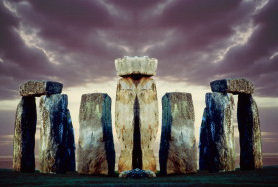Stonehenge’s wooden ‘lost twin’ discovered
Two brothers, Doctor and Professor Gaffney, both archaeologists, said this ‘incredible’ find just two weeks in to a three year mapping project has been enabled thanks to advances in mapping technology

Archaeologists studying the land around Stonehenge in Wiltshire have discovered the remains of another monument, being dubbed the structure’s “lost twin.”
The discovery encompasses a circular ditch though to have held a free standing wooden structure. It is made up of a segmented ditch with entrances to the north east and south west, and is being hailed as the most important find in the area for more than 50 years.
Found just 900 hundred meters from the ancient stone structure, the new discovery is being described as Stonehenge’s ‘timber equivalent.’ It is separate from the nearby Woodhenge, which was only discovered in 1925 when rings of dark spots were noticed in a crop of wheat.
What is a henge?
The word 'henge' is used to refer to prehistoric enclosures, essentially characterised by a raised circular bank and a circular ditch - with the ditch inside the bank rather than outside.
Henges typically have one or more entrances leading to an enclosed open space.
Because of the defensive impracticalities of an enclosure with an external bank and an internal ditch, henges are not considered to have served a defensive purpose.
Pre-historic discovery
The new find was made just two weeks into a three year study by the Stonehenge Hidden Landscape Project, made up of university teams from Britain, Austria, Germany, Norway and Sweden.
The multi million euro project is funded by the Austrian based Ludwig Boltzmann Institute and the University of Birmingham and is assisted by the National Trust and English Heritage, and the University of Bradford.
Using the latest geophysical imaging techniques, the project aims to map 5.5 square miles of land around Stonehenge.
Dr Christopher Gaffney, Lecturer in Archaeological Geophysics at the University of Bradford explains: “Rather than looking at typically small discrete areas we intend to cover the whole of the World Heritage Site.
“We will do this using emerging technology that allows us to pull large banks of sensors behind a quad bike and using real time GPS to locate the measurements.”
Stonehenge Hidden Landscapes Project
The Stonehenge Hidden Landscapes Project aims to virtually reconstruct the area as it looked around 2000 BC.
Started in early July it aims to bring together sophisticated geophysics teams with specialists in British prehistory and landscape archaeology.
Scientists will map and virtually excavate the terrain, pinpointing buried archaeological remains. The millions of measurements taken will then be put into gaming technology to produce 2D and 3D images.
Team member Professor Gaffney of the University of Birmingham said: “Visual and spatial technologies are revolutionising how archaeology and many other disciplines understand the past and the contemporary world.
“From digital objects to landscapes, through geophysics, geographical imaging systems and the creation of virtual worlds, new technology provides alternative routes to seeing and understanding both past and present.”
Technological advances
Essentially the team are taking a giant xray of the area around Stonehenge with the intention of creating an image of the site as it was in 4000 BC.
They will take images of the site for three weeks each year of the study, and spent the rest of the time analysing the data and trying to piece together what it means.
Similar projects have been attempted before. The Gaffney brothers worked together on a mapping program in Wroxeter in the 1990s. That study took three years to complete and they say they have discovered more data in the first two weeks on the Stonehenge project than in a decade’s worth of work on the Shrewsbury plot.
This they attribute to an “exponential development in mapping technology.”
Significance
Built in around 2400BC, Stonehenge is one of Britain’s most popular tourist hot spots, attracting more than 750,000 visitors every year.
Stonehenge
Stonehenge is a UNESCO world heritage site thought to be the world’s most famous pre-historic monument. It is made up of a circle of large stones and speculation on the reason for its construction range from human sacrifice to astronomy.
The surrounding landscape contains other stone circles and henges as well as barrows, mounds, hills and settlement remains. Highlights include the Normanton down barrow cemetery, Bush Barrow, the Stonehenge Cursus and the Avenue, a three kilometer long Pathway aligned with the solar patterns of the summer and winter solstices.
The structure is thought to have been constructed in three phases, requiring thirty million hours of labour.
English Heritage archaeologist Amanda Chadburn said the newly discovered monument was part of a growing body of evidence which showed how important the summer and winter solstices were to those who built Stonehenge.
“The discovery is all the more remarkable, given how much research there has been in the vicinity of Stonehenge, and emphasises the importance of continuing research within and around World Heritage Sites.”
Professor Gaffney says the team hope this Neolithic discovery is the first discovery of many –
“Stonehenge is one of the most studied monuments on earth, but this demonstrates that there is still much more to be found.”
-
Latest news
-
Taylor Swift’s new break-up album breaks records3m

-
NHS trust fined £200K for failings that led to death of two mental health patients3m

-
Sunak vows to end UK ‘sick note culture’ with benefit reform3m

-
‘Loose talk about using nuclear weapons is irresponsible and unacceptable’, says head of UN’s nuclear watchdog3m

-
‘There wasn’t an Israeli attack on Iran,’ says former adviser to Iran’s nuclear negotiations team7m

-




